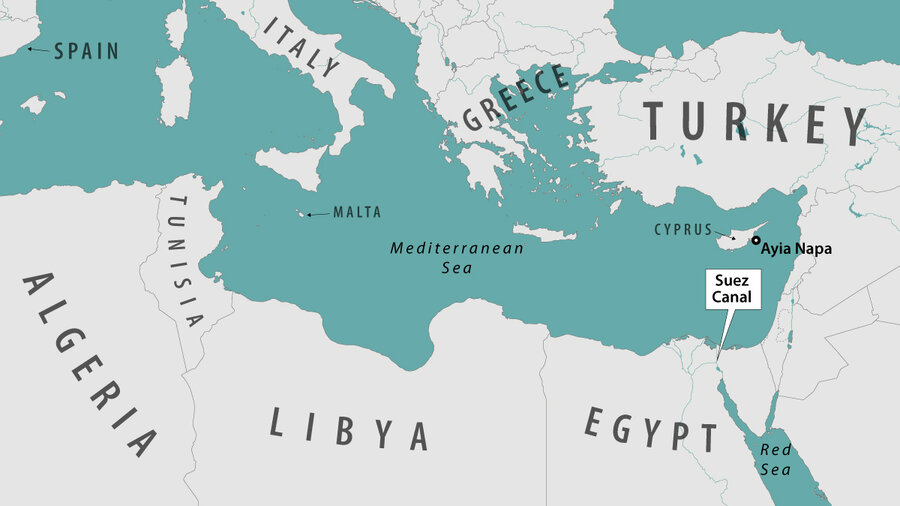It came from the (Red) Sea! Invasive fish spur creative responses in Cyprus.
Loading...
| Ayia Napa, Cyprus
Fishers in Cyprus are catching invasive fish from the Indian Ocean and Red Sea in place of calamari, sardines, and other traditional staples of beachside tavernas. Around 800 exotic species of marine life have entered the Mediterranean through the Suez Canal, posing acute challenges for the Cypriot fishing industry.
The exotic fish, drawn into the Mediterranean by warmer waters caused by global climate change, have disrupted the local fishing trade and are displacing the usual catches.
Why We Wrote This
Invasive fish species from the Red Sea threaten the Mediterranean. But scientists, fishers, and government officials are finding ways to mitigate their impact – if not turn them into dinner.
But scientists, fishers, and government officials have come up with ways to respond to the invaders. Bounties have been placed on the silver-cheeked toadfish, which are poisonous and tear up fishing nets. And fishers have turned the Pacific red lionfish into a profit-making catch.
How they adapt can offer lessons for the rest of the Mediterranean as the alien fish spread out into the rest of the sea, as they are expected to do.
“If we can keep track of the newcomers, if we detect them here, then other countries will have time to prepare for their arrival and adopt mitigating measures,” says Demetris Kletou of the Marine and Environmental Research Lab in Cyprus.
Blue and white fishing boats cluster in a busy harbor in Cyprus, their decks covered in ropes, baskets, and fishing nets. Fishers in sun-bleached caps sluice down the decks as cats forage for scraps in the shade – a typical Mediterranean scene.
What is much less typical is the catch these boats are pulling up from the ocean depths.
Cypriot fishers are snagging fish from the Indian Ocean and Red Sea in place of calamari, sardines, and other traditional staples of beachside tavernas. Around 800 exotic species of marine life, from fish to urchins, have entered the Mediterranean through the Suez Canal, posing acute challenges for the Cypriot fishing industry.
Why We Wrote This
Invasive fish species from the Red Sea threaten the Mediterranean. But scientists, fishers, and government officials are finding ways to mitigate their impact – if not turn them into dinner.
The exotic fish, drawn into the Mediterranean by warmer waters caused by global climate change, have disrupted the local fishing trade. Some of the new species are poisonous. Others damage fishers’ equipment. And they all are displacing the usual catches.
“Some fishermen are now reporting that their catches consist of mostly alien fish, or even exclusively alien fish,” says Nikolas Michailidis, from the Cyprus department of fisheries.
But scientists, fishers, and government officials have come up with ways to respond to the exotic species, ranging from killing them to eating them, that are allowing the fishing industry to adapt. And what they learn can offer lessons for the rest of the Mediterranean as the alien fish spread out into the rest of the sea, as they are expected to do.
Culling the toadfish
With temperatures rising 20% faster than the global average, the Mediterranean is the fastest-warming sea on the planet, the World Wide Fund for Nature warned in a report released in June.
The movement of exotic species has also been aided in recent years by the widening of the Suez Canal, which has changed salinity levels that previously acted as a barrier to aquatic migration.
That has allowed species like the much-loathed silver-cheeked toadfish to reach Cyprus. It is not only a prolific breeder and packed with a dangerous toxin, it also has powerful teeth with which it rips into fishing nets in order to get at the catch inside.
“They eat cuttlefish and octopus and calamari straight out of the net, before you can land it on the boat,” says Loucas Georgiou, a fisherman for 40 years who is based in the port of Ayia Napa in eastern Cyprus. “At depths of 200m to 300m, the sea is full of these fish.”
Matt Smith, a Briton who lives in Cyprus, often spots exotic species when he goes on diving trips. “I see a lot of silver-cheeked toadfish. They’re one of the most toxic fish in the world. They have teeth like a rabbit. And they don’t have any predators.”
“They’re very aggressive. They destroy the nets. They eat the catch inside. The species established itself really fast. They can eat anything,” says Mr. Michailidis. “The fish contain a paralyzing toxin – if you eat some, you stop breathing. A few milligrams can kill you.”
FisherS who catch them are paid a bounty of €3 a kilo ($1.57 per pound) to bring them into port. The toadfish are then incinerated in special furnaces, with around 50 tons burned each year.
Eating the aliens
In contrast to the unpalatable toadfish, Pacific red lionfish are eminently edible.
In fact they are delicious – once you remove the beautiful but poisonous spines that protrude from their brightly colored bodies. Fishers have learned how to do so safely, using knives and heavy, puncture-resistant gloves.
A market for the fish is gradually developing across Cyprus, with restaurant owners putting lionfish on their menus. The “invasivore” movement – also seen in Florida, where lionfish spread after escaping aquariums – encourages an apex predator, humans, to gobble up the invaders before they can eat native species.
In addition, teams of volunteer divers are sent out to spear lionfish. There are also lionfish “derbies” – contests to see how many can be caught – open to all comers.
“Two years ago, fishermen were discarding lionfish. But we managed to raise awareness about the species and people realized that it is delicious. Now we are seeing that fishermen are getting a good price, around €15 a kilo, and I think that will continue to rise,” says Periklis Kleitou, a marine scientist from Plymouth University in England. “It’s only very recently that lionfish are being eaten here.”
He is part of an EU-funded project called ReLionMed-Life which aims to monitor and control the population of lionfish in Cyprus waters.
Lionfish are to some extent compensating for the fact that fishers are catching far fewer native species in the island’s waters. “Because Cyprus’ waters have been overfished, 70% of seafood is imported, so lionfish can be a solution in offsetting that,” says Mr. Kleitou.
But the overall effect of the alien species on the fishing industry, so far at least, has been negative, he says. “Some fishermen are saying their income has been cut by 50% because of the damage done to their nets by toadfish and the loss of their catch.”
There are glimmers of hope. Marine scientists recently discovered that some native species are starting to prey on the alien invaders.
In a scientific study published in the journal Frontiers in Marine Science in July, scientists from Cyprus, Greece, Turkey, Britain, and Malta noted that loggerhead turtles sometimes eat adult silver-cheeked toadfish, while juvenile toadfish are preyed on by dolphinfish and garfish. Pacific red lionfish are being eaten by octopuses as well as groupers.
Natural predation is promising, but it is not enough. “The relative paucity in natural, native predators of these two highly invasive non-indigenous fish species suggests that direct human management measures need to be implemented in order to control their Mediterranean populations,” the report said.
“Other countries will have time to prepare”
As scientists and fishers come to terms with the alien invasion, they are acquiring knowledge that will be valuable to countries elsewhere in the Mediterranean.
It is the countries at the eastern end of the sea that have borne the brunt so far of the phenomenon, but many species are moving inexorably west, toward Greece, then Italy, Malta, and Spain.
“If we can keep track of the newcomers, if we detect them here, then other countries will have time to prepare for their arrival and adopt mitigating measures,” says Demetris Kletou, a marine biologist from the Marine and Environmental Research Lab in Limassol, Cyprus.
He describes Cyprus as the “doorstep” of the Mediterranean – the first European country that these species reach after they swim past the coasts of Egypt, Israel, and Syria.
“With the sea warming as it is, Italy will probably be in the same situation as us in 10 or 20 years, for instance,” he says.
The incursion of new species may not be all bad for Cyprus and the wider Mediterranean.
“There are some people who say that the more species we have, the greater biomass and biodiversity there is in the sea,” says Mr. Michailidis from the fisheries department. “They can be a food source for native species. You can’t really control these alien species; it’s almost impossible. Most of them are here to stay.”











